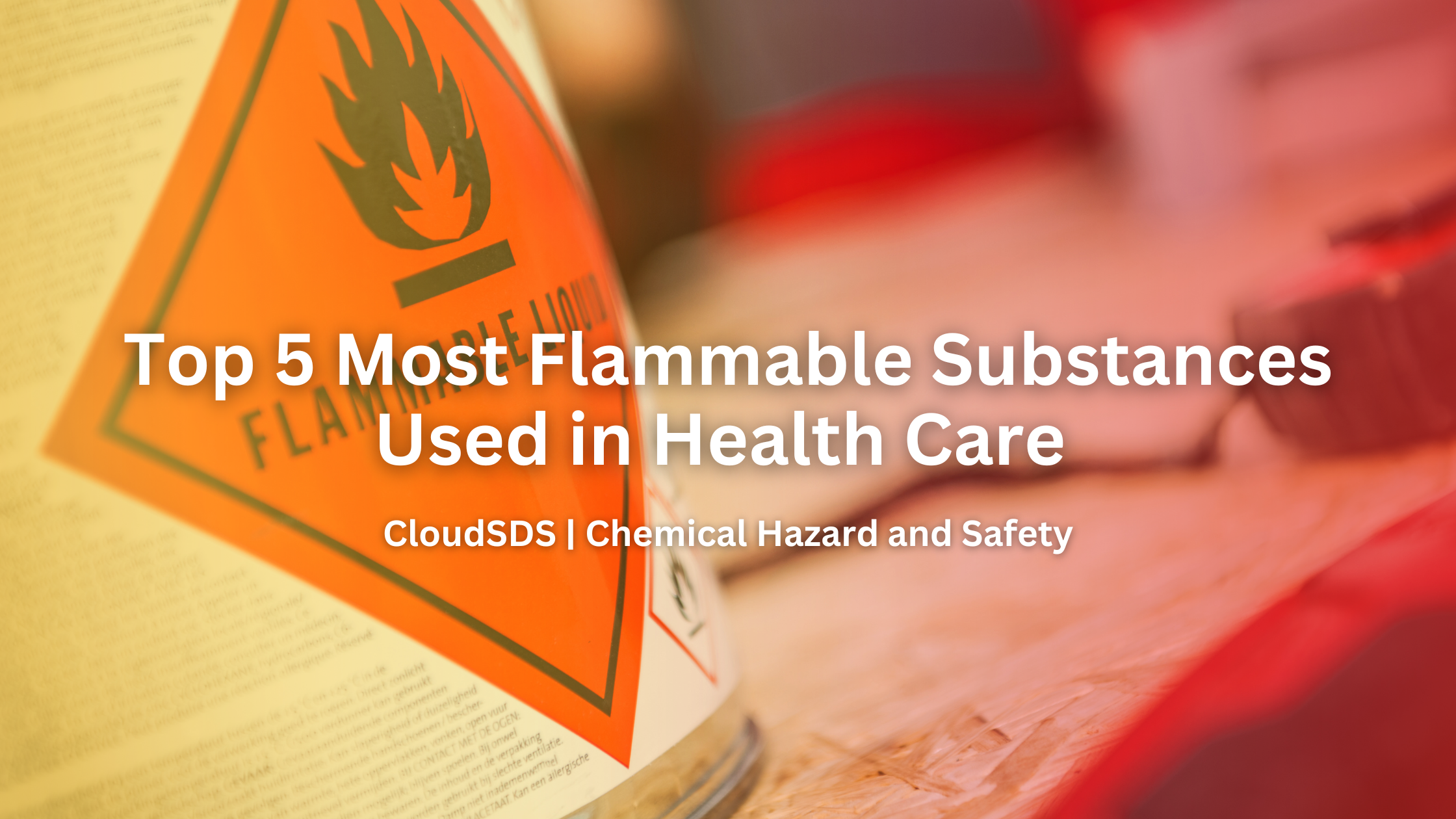Introduction
The use of different kinds of flammable substances is not a new thing in the health sector. This sector seems like the safest place on Earth, but behind the scenes, hospitals and medical centers across the United States store and use a variety of highly flammable substances. The Occupational Safety and Health Administration (OSHA) has given a clear standard for managing these risks. Yet, many health workers remain unaware of how flammable some common substances are.
This content will highlight the Top 5 Most Flammable Substances in the U.S. Based on OSHA’s classifications, healthcare shares essential safety tips to prevent dangerous incidents.
Why Flammable Substances Matter in Health Care
As per the OSHA standard, 29 CFR 1910.106, flammable liquids are defined as those with a flash point below 100°F (37.8°C). In health care, flammable materials are used in disinfection, sterilization, and surgical procedures, which makes fire safety a critical issue.
Health Care Sectors Must Adhere to OSHA Standards
Healthcare sectors must comply with the following OSHA standards:
29 CFR 1910.1200 – Hazard Communication Standard
- Health organizations must ensure all chemicals are labeled with hazard warnings.
- Maintaining updated Safety Data Sheets (SDS) is necessary.
- Employees must go for training in chemical risks.
29 CFR 1910.106 – Flammable and Combustible Liquids
- Health organizations must provide OSHA-approved storage cabinets.
- Storage quantities in patient care areas should be limited.
- There should be restrictions on the number of flammable substances stored in patient care areas.
- Containers should be properly grounded and bonded during chemical transfers to prevent static discharge.
29 CFR 1910.1047 – Ethylene Oxide Standard
- Health organizations should implement air quality monitoring and enforce exposure limit controls to ensure a safe working environment.
- Leak detection and ventilation systems should be available.
- Comprehensive training is necessary for handlers.
Top 5 most flammable substances
-
Isopropyl Alcohol (IPA)
Isopropyl alcohol is one of the most widely used disinfectants in hospitals. It’s used for everything from cleaning wounds to disinfecting surgical instruments and surfaces. While effective, it poses a serious fire hazard.
Flash Point: ~53°F (12°C)
OSHA Classification: Class IB Flammable Liquid
Usage:
Isopropyl alcohol of IPA is commonly used for cleaning and disinfecting surfaces and skin.
Risks:
- Its low flash point makes it extremely volatile. When vapors accumulate, even a small spark can trigger a fire.
- Highly flammable vapors can ignite from static electricity or heat sources.
- Spilled IPA on clothing or equipment can create fire hazards.
OSHA Safety Tips:
- Store IPA in OSHA-compliant flammable cabinets.
- Use only in well-ventilated areas.
- Ensure containers are appropriately labeled.
- Keep away from ignition sources.
- Train staff in emergency procedures and spill response.
-
Ethyl Alcohol (Ethanol)
Ethyl alcohol is commonly used in alcohol-based hand sanitizers (ABHS), especially in concentrations of 60%–95%. While effective in controlling the spread of infectious diseases, its low flash point makes it highly flammable.
- Flash Point: ~55°F (13°C)
- OSHA Classification: Class IB Flammable Liquid
- Common Uses-Alcohol-based hand sanitizers (ABHS) often contain 60–95% ethanol, making them highly flammable. In small, enclosed areas, vapors can easily reach explosive levels.
Risks:
- Rapid vaporization and easy ignition.
- Improper storage of bulk containers increases the risk of explosion.
OSHA Safety Tips:
- Avoid storing near ignition sources or heat-generating medical equipment.
- Follow NFPA 30 standards for storing flammable liquids.
- Install proper ventilation systems.
- Post warning signs in storage areas.
-
Ethylene Oxide (EtO)
Ethylene oxide is a powerful sterilant used in many healthcare sectors. It’s both a health hazard and a fire risk, capable of forming explosive mixtures with air.
Flash Point: Below room temperature
OSHA Classification: Highly Flammable, Hazardous Chemical (1910.1047)
Common Uses– Sterilization of medical equipment
Risks-Ethylene Oxide is both flammable and toxic. It can form explosive mixtures with air and is also classified as a carcinogen. Hospitals use it in gas sterilization chambers.
OSHA Guidelines:
- Use in sealed, ventilated systems
- Perform regular air monitoring
- Use explosion-proof equipment
-
Nitrous Oxide (N₂O)
Nitrous oxide is not flammable but acts as an oxidizer, intensifying combustion of other substances. In operating rooms or dental clinics where alcohol and plastics are used, N₂O becomes a high-risk substance.
OSHA Classification: Oxidizer (supports combustion)
Common Uses: Dental and surgical anesthesia
Risks:
- It enhances the burning rate of flammable substances.
- Accidental leaks may increase fire potential in OR environments.
OSHA Safety Tips:
- Secure cylinders to prevent tipping or damage.
- Keep away from flammable liquids and oils.
- Use in well-ventilated environments.
- Regularly inspect fittings, hoses, and connectors.
-
Medical Oxygen (O₂)
While oxygen is essential in healthcare, it’s also a dangerous accelerant. Increased oxygen concentrations dramatically raise the flammability of fabrics, plastics, and alcohol-based products. It doesn’t catch fire, but it dramatically increases the combustibility of other materials. In environments with flammable substances, a leak from an oxygen tank can turn a small spark into a deadly blaze.
- OSHA Classification: Oxidizer
- Common Uses: Patient respiratory therapy, surgical procedures
Risks:
- It doesn’t catch fire, but it dramatically increases the combustibility of other materials.
- Oxygen-enriched environments cause materials to ignite more easily.
- Leaking oxygen tanks near flammable materials can lead to explosions.
OSHA Safety Tips:
- Store cylinders in upright, secured positions.
- Post “No Smoking” signs in oxygen-rich zones.
- Use oxygen-safe lubricants and fittings.
- Train staff in the correct procedures for handling and transporting cylinders.
- Keep tanks away from oil, grease, and flammables.
- Use oxygen-specific fittings and leak detectors.
Conclusion:
The above-mentioned flammable substances in healthcare are unavoidable, but accidents are not. By following OSHA classifications, enforcing strict protocols, and investing in staff training, healthcare organizations can significantly reduce the risk of fire and chemical exposure. As a hospital administrator, lab technician, or safety officer, staying compliant with OSHA’s guidelines isn’t just a regulatory requirement; it’s a commitment to patient and staff safety.






Leave A Comment